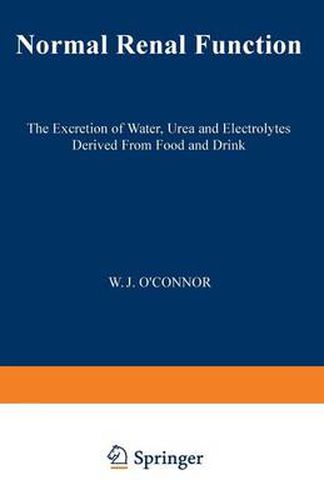Readings Newsletter
Become a Readings Member to make your shopping experience even easier.
Sign in or sign up for free!
You’re not far away from qualifying for FREE standard shipping within Australia
You’ve qualified for FREE standard shipping within Australia
The cart is loading…






This title is printed to order. This book may have been self-published. If so, we cannot guarantee the quality of the content. In the main most books will have gone through the editing process however some may not. We therefore suggest that you be aware of this before ordering this book. If in doubt check either the author or publisher’s details as we are unable to accept any returns unless they are faulty. Please contact us if you have any questions.
This book has developed from an earlier monograph, ‘Renal Function’ (1962; London, Edward Arnold). It retains the general purpose of that book in relating the composition of the blood to the volume and com position of the urine of animals, including the new data of the intervening 20 years. As indicated by its title, this new book also has the particular purpose of studying the urine of animals in a normal environment and eating food usual to the species. Renal physiology illustrates a dilemma which arises also in other fields. Advanced technology, harnessed by accumulated experimental skill, now allows detailed investigation of basal processes. Micropuncture experiments have greatly advanced our understanding of the processes of glomerular fil tration and tubular reabsorption and have contribut ed to the wider discussion of the physicochemical nature of the movement of water and ions across cell surfaces. But experiments at microscopic or cell ular level demand experimental conditions in which the systems are abstracted from their natural en vironment, either as isolated perfused preparations or with the anaesthetised animal merely providing support for a tissue left in situ. The arguments from such experiments, important though they are towards understanding the basal processes, readily become remote from the reality of the normal animal.
$9.00 standard shipping within Australia
FREE standard shipping within Australia for orders over $100.00
Express & International shipping calculated at checkout
Stock availability can be subject to change without notice. We recommend calling the shop or contacting our online team to check availability of low stock items. Please see our Shopping Online page for more details.
This title is printed to order. This book may have been self-published. If so, we cannot guarantee the quality of the content. In the main most books will have gone through the editing process however some may not. We therefore suggest that you be aware of this before ordering this book. If in doubt check either the author or publisher’s details as we are unable to accept any returns unless they are faulty. Please contact us if you have any questions.
This book has developed from an earlier monograph, ‘Renal Function’ (1962; London, Edward Arnold). It retains the general purpose of that book in relating the composition of the blood to the volume and com position of the urine of animals, including the new data of the intervening 20 years. As indicated by its title, this new book also has the particular purpose of studying the urine of animals in a normal environment and eating food usual to the species. Renal physiology illustrates a dilemma which arises also in other fields. Advanced technology, harnessed by accumulated experimental skill, now allows detailed investigation of basal processes. Micropuncture experiments have greatly advanced our understanding of the processes of glomerular fil tration and tubular reabsorption and have contribut ed to the wider discussion of the physicochemical nature of the movement of water and ions across cell surfaces. But experiments at microscopic or cell ular level demand experimental conditions in which the systems are abstracted from their natural en vironment, either as isolated perfused preparations or with the anaesthetised animal merely providing support for a tissue left in situ. The arguments from such experiments, important though they are towards understanding the basal processes, readily become remote from the reality of the normal animal.